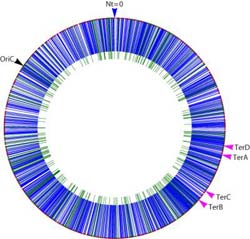New research presents most extensive pictures ever of an organism's DNA mutation processes

This circle represents the Escherichia coli chromosome with 1,931 mutations. Blue lines represent base-pair substitutions and green lines represent the gain or loss of between one and four nucleotides.<br><br>Credit: Andrew J. Hanson, School of Informatics and Computing, Indiana University<br>
Biologists and informaticists at Indiana University have produced one of the most extensive pictures ever of mutation processes in the DNA sequence of an organism, elucidating important new evolutionary information about the molecular nature of mutations and how fast those heritable changes occur.
By analyzing the exact genomic changes in the model prokaryote Escherichia coli that had undergone over 200,000 generations of growth in the absence of natural selective pressures, the team led by IU College of Arts and Sciences Department of Biology professor Patricia L. Foster found that spontaneous mutation rates in E. coli DNA were actually three times lower than previously thought.
The new research, which appears today in early editions of the journal Proceedings of the National Academy of Sciences, also notes that the mismatch repair proteins that survey newly replicated DNA and detect mistakes not only keep mutation rates low but may also maintain the balance of guanine-cytosine content to adenine-thymine content in the genome. Guanine-cytosine and adenine-thymine are the nitrogenous bases that bond between opposing DNA strands to form the rungs of the double helix ladder of DNA.
“We know that even in the absence of natural selection, evolution will proceed because new mutations get fixed at random in the genome,” Foster said. “So, if we want to determine whether specific patterns of evolutionary change are driven by selection, knowledge of the expected pattern in the absence of selection is absolutely essential. Here we are defining the rate and molecular spectrum of spontaneous mutations while minimizing the ability of natural selection to promote or eradicate mutations, which allows us to capture essentially all mutations that do not cause the bacterium to die.”
In a parallel mutation accumulation experiment using a strain defective in mismatch repair, in which the mutation rate was increased over 100-fold, the researchers analyzed nearly 2,000 mutations and found that these were strongly biased toward changing adenine-thymine base pairs to guanine-cytosine base pairs, the opposite of what is seen in the normal bacteria.
E. coli chromosome
“The molecular spectrum of spontaneous base-pair substitutions in almost all organisms is dominated by guanine-cytosine to adenine-thymine changes, which tends to drive genomes toward higher adenine-thymine content,” Foster noted. “Because the guanine-cytosine content of genomes varies widely, there must be some selective pressure, or some non-adaptive mechanism, that can drive genomes back toward increased guanine-cytosine content.”
The new research, co-authored by IU Bloomington School of Informatics and Computing associate professor Haixu Tang, Informatics predoctoral researcher Heewook Lee and Department of Biology postdoctoral researcher Ellen Popodi, demonstrates that mismatch repair is a major factor in the types of mutations that occur and in determining the base composition of the genome. Because the activity of mismatch repair can be influenced by the environment, another implication of this work is that the pattern of mutations could be used in forensics to help determine where a particular bacterial strain originated.
“By establishing baseline parameters for the molecular nature of spontaneous mutational change unbiased by selection, we can begin to achieve a deeper understanding of the factors that determine mutation rates, the mutational spectra, genomic base composition, how these may differ among organisms and how they may be shaped by environmental conditions,” Foster said. “Since mutations are the source of variation upon which natural selection acts, understanding the rate at which mutations occur and the molecular nature of spontaneous mutational changes leads us to a fuller understanding of evolution.”
The research took nearly two years to complete and was supported by a Multidisciplinary University Research Initiative Award from the U.S. Army Research Office.
Media Contact
More Information:
http://www.iu.eduAll latest news from the category: Life Sciences and Chemistry
Articles and reports from the Life Sciences and chemistry area deal with applied and basic research into modern biology, chemistry and human medicine.
Valuable information can be found on a range of life sciences fields including bacteriology, biochemistry, bionics, bioinformatics, biophysics, biotechnology, genetics, geobotany, human biology, marine biology, microbiology, molecular biology, cellular biology, zoology, bioinorganic chemistry, microchemistry and environmental chemistry.
Newest articles

Superradiant atoms could push the boundaries of how precisely time can be measured
Superradiant atoms can help us measure time more precisely than ever. In a new study, researchers from the University of Copenhagen present a new method for measuring the time interval,…

Ion thermoelectric conversion devices for near room temperature
The electrode sheet of the thermoelectric device consists of ionic hydrogel, which is sandwiched between the electrodes to form, and the Prussian blue on the electrode undergoes a redox reaction…

Zap Energy achieves 37-million-degree temperatures in a compact device
New publication reports record electron temperatures for a small-scale, sheared-flow-stabilized Z-pinch fusion device. In the nine decades since humans first produced fusion reactions, only a few fusion technologies have demonstrated…





















